Understanding Bicycle Braking Systems
Table of Contents
Bicycle brakes perform the obvious vital function of slowing or stopping a bike. Naturally, a rider needs brakes that are not only in good working order, but that are also designed to work for their specific riding conditions. Over the years there have been many different designs of bicycle brakes with some becoming more popular than others.
Rim Brakes
Rim brakes, in general, are the most effective and have been the most popular for many years. They provide adequate braking power without too much maintenance. They are controlled by hand levers which are attached to the actual brake by a cable. When the rider pulls on the lever the cable moves the brakes and two pads, one on each side, press against the rim causing the wheel to slow down.
There are 2 categories of rim brakes:
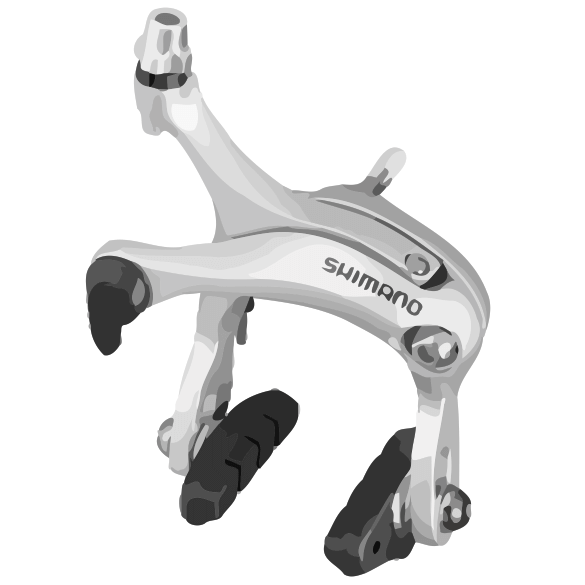 Caliper Brakes
Caliper BrakesCaliper brakes attach directly onto the fork or frame by one bolt, just above the tire. Two arms reach down to either side of the wheel. Normally these brakes are installed on road bikes and for this use they provide quite adequate stopping power. Their disadvantage is that they cannot wrap around thick tires, and the fork and frame need holes for the bolts to pass through.
There are various types of caliper brakes, but they all work using the same principle. Some caliper brakes have the cable to one side while others have the cable directly in the middle, hence the terms side-pull and centre-pull.
Dual pivot refers to caliper brakes where one arm pivots at the centre and the other arm attaches to the side of the inside arm and pivots at the side. This makes them easier to adjust so both pads connect with the rim at the same time.
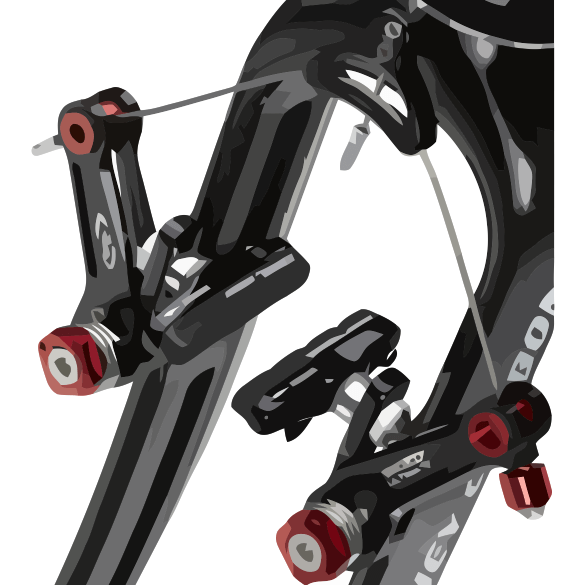 Centre Pull Cantilever Brakes
Centre Pull Cantilever BrakesCantilever brakes have two totally separate arms with each arm attaching onto each side of the fork and onto each side of the seat stays. The frame and fork must have brazed-on fittings for the bolts to hold on to. These brakes are normally used on mountain bikes which require extra stopping power particularly when going down hill. They are also not affected by wet conditions as much as other brakes and they have the advantage of not being limited to thin tires as they do not pass over it.
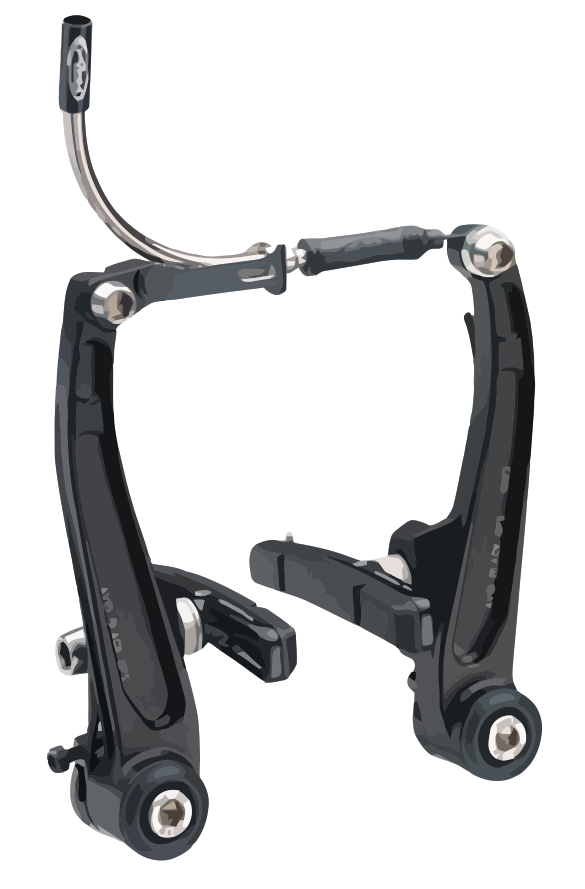 Cantilever V-Brakes
Cantilever V-BrakesV-Brakes are a variation of the traditional cantilever brake. They are also called linear-pull brakes and direct-pull brakes. The difference is that the cable comes in from one side.
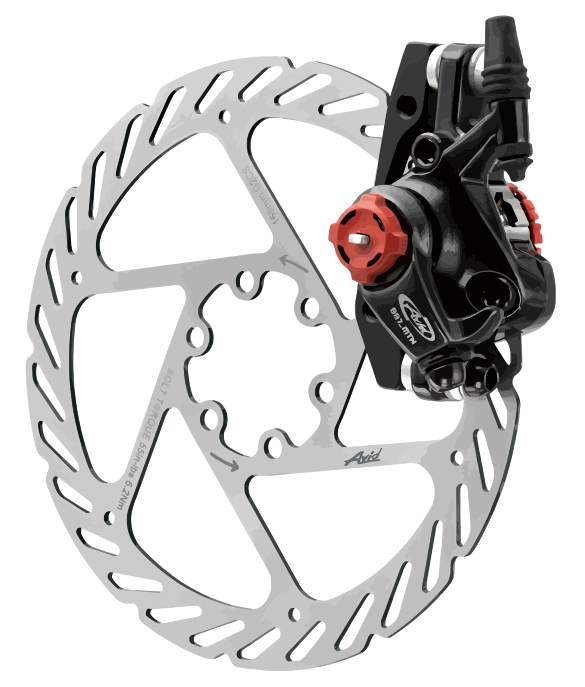 Rotor and Cable (not shown) Disc Brakes
Rotor and Cable (not shown) Disc BrakesDisk Brakes
During the past several years disc brakes have become quite popular. Their main advantage is their stopping power and because they don't touch the rim they will continue to work even if a wheel is warped. They rely on a disc rotor which is attached to the hub. Special brake pads, held in place by the braking mechanism, squeeze the rotor causing the wheel to slow down.
Cable Disc Brakes,as the name implies work with a cable attached to the brake lever on the handle bars. This is the easiest type to maintain and is less expensive than the hydraulic type. For most riders it provides plenty of stopping power, but is not as ‘crisp' as hydraulic brakes.
Hydraulic Disk Brakes still have a cable housing attached from the brake lever to the actual brake. But, instead of a cable in the housing there is mineral oil. The pads contract via pressure that the oil provides when the levers are pulled. Hydraulic brakes provide stronger braking power than cable brakes, however, they occasionally need ‘bleeding' to remove air bubbles from the housing.
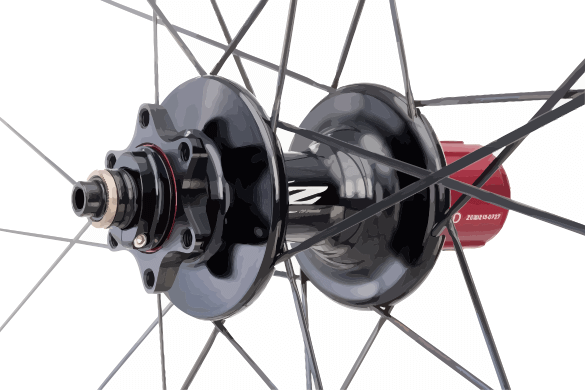 Rear hub with the ability to have a rotor attached
Rear hub with the ability to have a rotor attachedDisc brake considerations:
- The rotor must be very clean in order for the pads to ‘grab' it. Isopropyl is an excellent cleaning solution.
- The actual brake pads must never be touched or contaminated by dirt or oil. Contamination will damage them, and they will probably need replacing, as there is no way to clean them.
- The bike must be designed to accept disc brakes. The fork and frame must have braze-ons for the bolts and the hubs must be able to hold a rotor.
- If the rotor bends, usually from an accident, you will need to straighten to prevent the brakes from rubbing.
- At first they were reserved only for mountain bikes, then they began to be used on cyclocross bikes. As they have become lighter, they are now being used on road bikes in professional races. Since road bikes are so light a bit of extra weight from disc brakes has become acceptable.
 Drum Brake
Drum BrakeDrum Brakes
These brakes are enclosed in the rear hub. They are not affected by wet conditions and they require less maintenance. However, they are heavier than rim brakes and disc brakes, and until they are used a bit their braking power is not as strong.
Drum brakes work with a cable which is attached to the lever on the handle bars. They are often used on commuter bikes. Usually the rear hub allows for gears, but not with an external derailleur. The gears are internal, inside the hub, and usually do not have more than 8 possible gears.
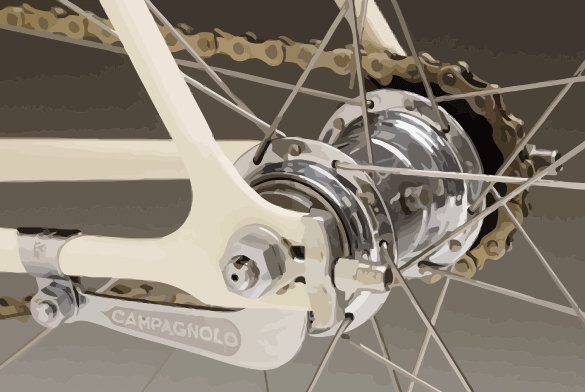 Coaster Brakes
Coaster BrakesCoaster Brakes
These types of brakes have been around for many years. They are usually found on kids bikes, and do not work on bikes with rear gears (unless the gears are in the hub). They have a metal attachment which connects onto the chain stay. When you try to pedal backwards the rear wheel slows down. The mechanism is quite simple, no cables, no hand levers, and very little maintenance. However, they are only for the rear wheel. The risk is skidding when one stops suddenly. You can coast without pedalling, but you cannot move the pedals backwards since this would engage the braking mechanism.
 Single gear rear wheel. If this was a flip-flop it would also have a cog on the other side.
Single gear rear wheel. If this was a flip-flop it would also have a cog on the other side.Fixed Gear Braking
Fixed gear bikes do not have the ability to coast. Meaning, if you are moving forward, so must the pedals. The rear cog is fixed. This bike is mostly used for track cycling, but they have also caught on with couriers for their simplicity and ease of maintenance. If you choose to ride this kind of bike on the road you should still have regular cable brakes, at least for the front wheel.
Some single gear bikes have the option of a flip-flop wheel. This means on one side the rear cog is fixed, but when you flip the wheel, the other side cog is still single, but it can coast. This means you cannot stop with your pedals and so you'll need regular rim brakes.
Note, simply by looking at the rear wheel of a single gear bike, you can't tell if it is fixed or a coaster.
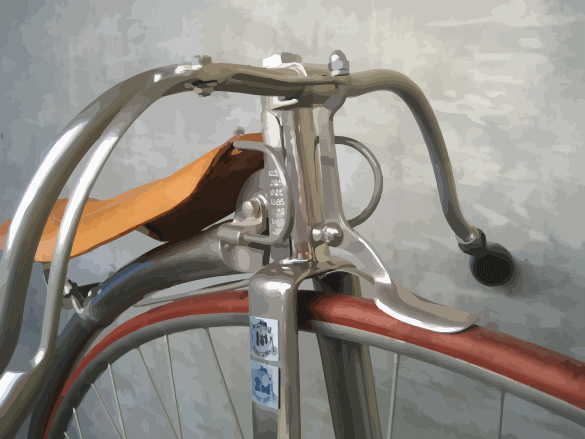 Spoon Brake
Spoon Brake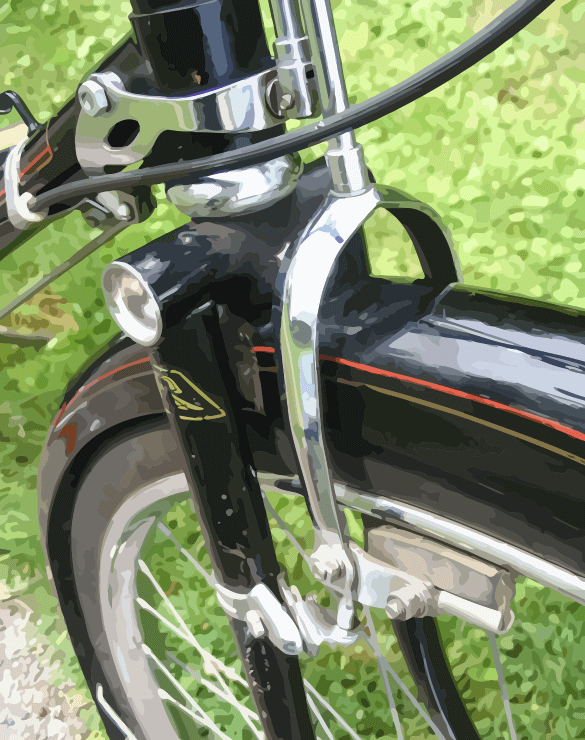 Rod Braking System
Rod Braking System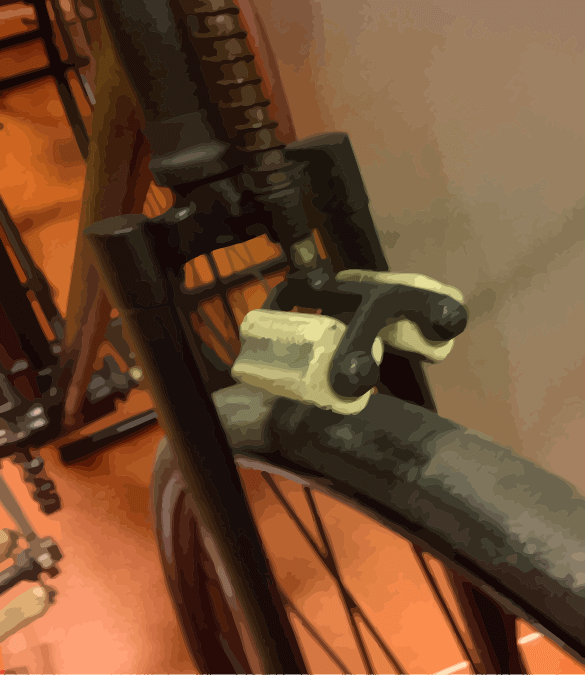 Duck Brake
Duck Brake
Other Braking Systems
The braking systems described above are the most popular, but there are some other rarer systems you may come across.
Spoon brake:
As the name implies, there is a spoon shaped piece of metal that presses directly on the front tire to slow it down. The braking force is minimal and can quickly damage the tire.
Rod Actuated Brake:
This system has rods coming from the hand lever that would pull up on two pads which would then put pressure on the inside of the rim.
Duck brake:
Similar to the spoon brake, except the mechanism is two rubber rollers that are pushed directly onto the tire.



Leave a Reply